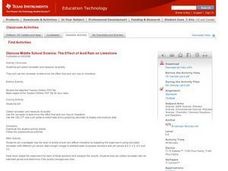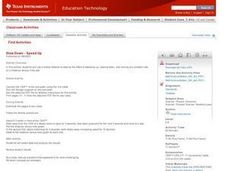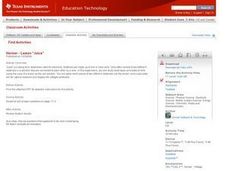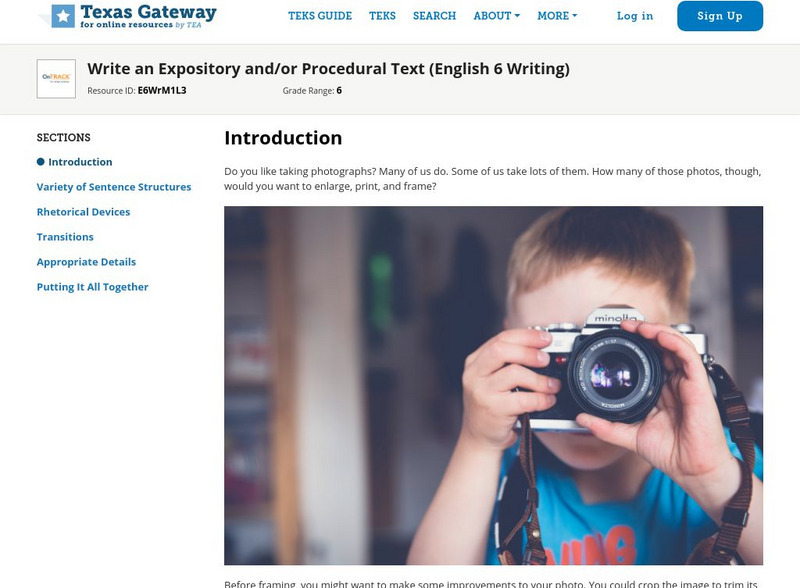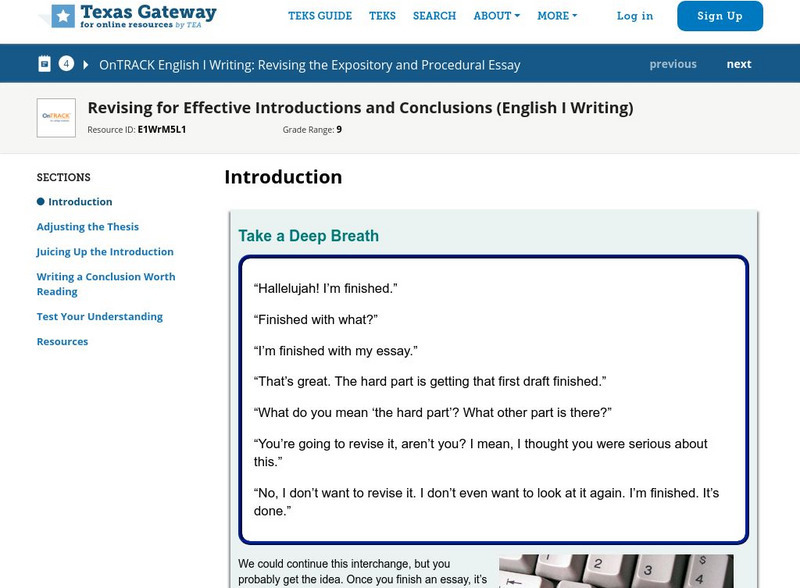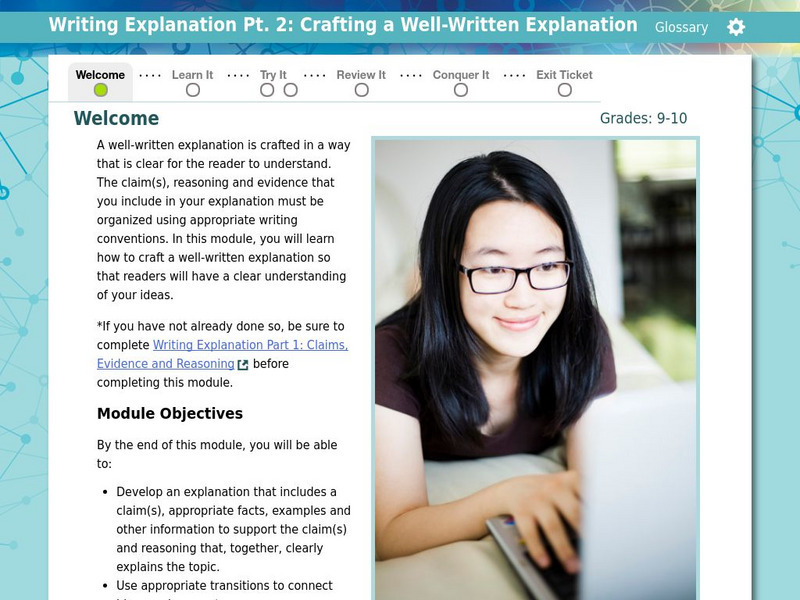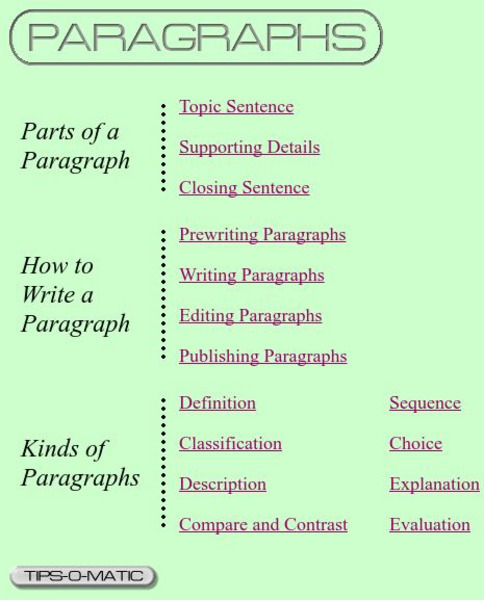Texas Instruments
Measuring Air Pressure Lab
Your class can investigate the weather through an experiment. In this chemistry lesson, learners collect data on air pressure and relate it to the weather. They collect data with the TI containing a barometer probe.
Curated OER
Biodiversity and Ecosystems
Middle schoolers differentiate between biotic and abiotic factors in this science instructional activity. Learners collect data for the experiment and analyze the data after graphing it using the CBL 2. This experiment is split into two...
Curated OER
The Disappearing Kelp Forest
Learners observe the effect "El Nino" left on kelp plants and sea urchins. They analyze the data collected by researchers, by graphing it on a TI calculator. Before graphing and analyzing the data, you may want to revisit the events of...
Curated OER
Match Me!
Young learners explore motion graphs in this lesson. They investigate distance-time plots as they move in a specific way in front of the CBR in an attempt to make a motion plot that matches a given plot. Pupils explore the connections...
Curated OER
Shedding Light on the Weather with Relative Humidity
Learners study weather using a graphing calculator in this lesson. They collect data for temperature and relative humidity for every hour over a day from the newspaper, then place the data in their handheld calculator and examine it for...
Curated OER
Does Clear Water mean Healthy Water?
Learners test their local aquatic site to determine its water clarity. They collect a water sample and measure its turbidity using a sensor, then they repeat the experiment to obtain a second turbidity reading to find the average value.
Curated OER
The Effect of Acid Rain on Limestone
Pupils investigate the pH of rain water in this earth science lesson. They collect rain water from their area and explore the pH when lime stone is added, then they will use the data collected to conjecture as to the effect of acid rain...
Curated OER
Which Way?
Middle schoolers explore distance-time plots. In this algebra lesson, they will investigate how different types of motion affect the distance-time plot.
Curated OER
What's Your Speed?
Learners explore the concept of distance v. time. They use a CBR to collect data on their distance over time, then plot their data using a scatter plot and find an equation to model their data. Pupils discuss what if scenarios which...
Texas Instruments
Light and Day
Pupils explore the concept of collecting data as they collect data on their graphing calculator about time, temperature, and light. Learners plot the data and create histograms and box and whisker plots to analyze the data.
Curated OER
Slow Down - Speed Up
Pupils explore the concept of distance and time as they use a CBR to mimic distance v. time graphs. Learners walk towards and away from the monitor to create various distance v. time graphs, then discuss what motion creates certain graphs.
Curated OER
Lemon "Juice"
Middle schoolers explore the concept of electricity in this lesson as they measure the electricity that a lemon gives off. Learners use volt meters to measure the amount of electricity coming from the lemon. Your class will also...
Sophia Learning
Sophia: Analytical Papers: Organization
This slideshow tutorial focuses on organizing an analytical paper; it defines analysis and outlines the basic five- paragraph essay format. It discusses what goes into the introduction, the body paragraphs, and the conclusion. It...
Beacon Learning Center
Beacon Learning Center: Trailblazing Conclusions
This tutorial focuses on conclusions for expository writing. It discusses the purpose of conclusions, what should be included, and ways to conclude.
Sophia Learning
Sophia: I Just Got Assigned a Paper, Now What?
This lesson focuses on what to do after being assigned a paper; it provides the basic steps to writing a paper: brainstorm topics, organize your thoughts (Venn diagrams, tree diagram examples), conduct preliminary research, create a...
Texas Education Agency
Texas Gateway: Write an Expository And/or Procedural Text (English 6 Writing)
You will learn how to write an expository/procedural text with a variety of sentence structures, rhetorical devices, transitions, appropriate facts, and details.
Texas Education Agency
Texas Gateway: Revising for Effective Introductions and Conclusions
[Accessible by TX Educators. Free Registration/Login Required] Learn strategies for evaluating and revising an introduction, conclusion, and controlling idea or thesis in an essay.
Online Writing Lab at Purdue University
Purdue University Owl: Body Paragraphs
This Purdue University OWL (Online Writing Lab) provides information related to writing body paragraphs for argumentative essays.
Thinkport Education
Thinkport: Writing Explanation Pt. 2: Crafting a Well Written Explanation
In this module, students will write an explanation about climate change based on the claims, evidence and reasoning they identified in the Writing Explanation Part 1: Claims, Evidence and Reasoning.
Thinkport Education
Thinkport: Writing Explanation Part 3: Building an Argument
In this module, students will explore how claims, counterclaims, evidence and reasoning are used to write an effective argument. Students will read texts that discuss the climate change debate.
Capital Community College Foundation
Guide to Grammar and Writing: The Five Paragraph Essay
Explains what each paragraph of the five-paragraph essay, should do. Then gives a side-by-side analysis of a sample essay, pointing out aspects of the introduction and thesis statement, the paragraph-by-paragraph development, and the...
ACT360 Media
Writing Den: Paragraphs
How do you write a paragraph? Use this site to learn more about the different parts of a paragraph.
Other
Glendale College: Structure of the Five Paragraph Essay
This website from the Glendale Community College shows the structure of five paragraph essays and the elements within the paragraphs (motivator, thesis sentence, topic sentence, specific support, reworded thesis, clincher). Gives...
Other
Indiana University of Pennsylvania: Writing Center: Writing Strong Conclusions
This Indiana University of Pennsylvania Writing Center site provides tips to writing a strong conclusion to an essay. The article discusses incorporating an anecdote, a basic summary, a startling summary, famous ideas, and/or hints to...








